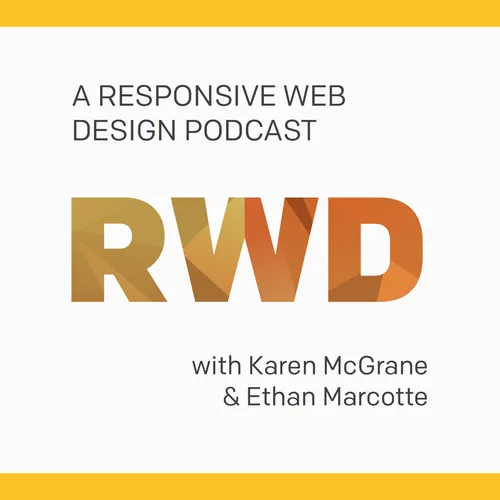
A Responsive Web Design Podcast
A podcast from Karen McGrane and Ethan Marcotte, who interview the people who make responsive designs happen.
- Update frequency
- every 7 days
- Episodes
- 157
- Years Active
- 2014 - 2018

Episode #57: Radio Free Europe/Radio Liberty
What if site speed were actually a life-or-death matter? Kim Conger from Radio Free Europe/Radio Liberty worked with Dan Mall and Tim Kadlec to make performance the top priority.
Mon 12 Oct 2015

Episode #56: The Great Discontent
Think no one wants to read long articles on their phone? Ryan Essmaker and Brad Smith tell us The Great Discontent readers spend more time on their phones, so responsive design makes sense.
Mon 05 Oct 2015

Episode #55: Royal Albert Hall
Who visits the Royal Albert Hall on their phone? Louise Halliday and Jake Grimley report that designing mobile-first means a website that works better for everyone.
Mon 28 Sep 2015

Episode #54: Moosejaw
Should retailers just accept low conversion rates on mobile? Eoin Comerford and Steve Anders from Moosejaw say it delivers business value to design—and redesign—responsively.
Mon 21 Sep 2015

Episode #53: ProPublica
Do you need to make your entire site responsive from the start? David Sleight from ProPublica explains that starting with individual feature stories is a safe way to experiment.
Mon 14 Sep 2015

Episode #52: The Specialest of Very Special Episodes
We’ve recorded an entire year of podcast episodes. In this year-end retrospective, we talk about our forthcoming books and discuss the whole adaptive versus responsive debate.
Mon 24 Aug 2015

Episode #51: West Virginia University
Responsive design is about more than fluid grids and media queries. Dave Olsen from West Virginia University explains how he advocates for content audits, pattern libraries, and in-browser prototypin…
Mon 17 Aug 2015

Episode #50: Notre Dame
How do you support mobile users across more than 460 university websites? Turns out responsive design is the best answer, according to Erik Runyon from Notre Dame.
Mon 10 Aug 2015

Episode #49: Seventh Generation
How does a responsive design support storytelling? Sarah Thompson and Ethan Winn show how a collaborative process and a modular architecture helped Seventh Generation support their content strategy.
Mon 03 Aug 2015

Episode #48: OZY
Most companies have an existing website they want to make responsive. Ryan Mannion from OZY tells us about building and maintaining a site that’s been responsive from the start.
Mon 27 Jul 2015

Episode #47: Fontsmith
Why would people browse fonts on their phone when they’re buying fonts for desktop computers? Jason Smith and Marcus Taylor explain why Fontsmith needs to work on every device.
Mon 20 Jul 2015

Episode #46: City of Surrey
Can a responsive redesign change the way city government works? Geoffrey Daniel and Steve Fisher explain how this website project changed the way the City of Surrey interacts with citizens.
Mon 13 Jul 2015

Episode #45: Google+
How does Google make a responsive site that performs as fast as possible across a variety of different browsers? Malte Ubl and Wahbeh Qardaji explain their responsive design process for Google+.
Mon 06 Jul 2015

Episode #44: The Atlantic
One of the most innovative digital publishers is 150-year-old The Atlantic. Libby Bawcombe and Betsy Ebersole explain how responsive design serves their customers who visit on both mobile and desktop…
Mon 29 Jun 2015

Episode #43: BBC News
The BBC has spent the past four years developing their Responsive News site. Niko Vijayaratnam and John Cleveley provide an in-depth look at the process required to deliver this massive project.
Mon 22 Jun 2015

Episode #42: Washington Post: Valar Morghulis
Game of Thrones’ rabid fan base means lots of social sharing on mobile. Joey Marburger and Shelly Tan describe their process for creating a responsive interactive feature for The Washington Post.
Mon 15 Jun 2015

Episode #41: OpenTable
Responsive and adaptive solutions can work together. Tom Stovicek from OpenTable explains why they went responsive but also maintain an m-dot site for some device-specific scenarios.
Mon 08 Jun 2015

Episode #40: National Audubon Society
A redesign of the Audubon website performed better than their wildest expectations. Mark Jannot and Mike Monteiro explain there wasn’t even a question about going responsive.
Mon 01 Jun 2015

Episode #39: Meniga
“Responsive design is great if you have a blog, but it will never work for a complex financial application.” Einar Thor Gustafsson and Tinna Karen Gunnarsdottir from Meniga prove that myth false.
Mon 25 May 2015

Episode #38: Wired
The Wired redesign has it all: a new process based on prototyping, fresh design, structure, and publishing tools, increased ad inventory and viewability, and team-wide focus on speed.
Mon 18 May 2015
Disclaimer: The podcast and artwork embedded on this page are the property of A Responsive Web Design Podcast. This content is not affiliated with or endorsed by eachpod.com.